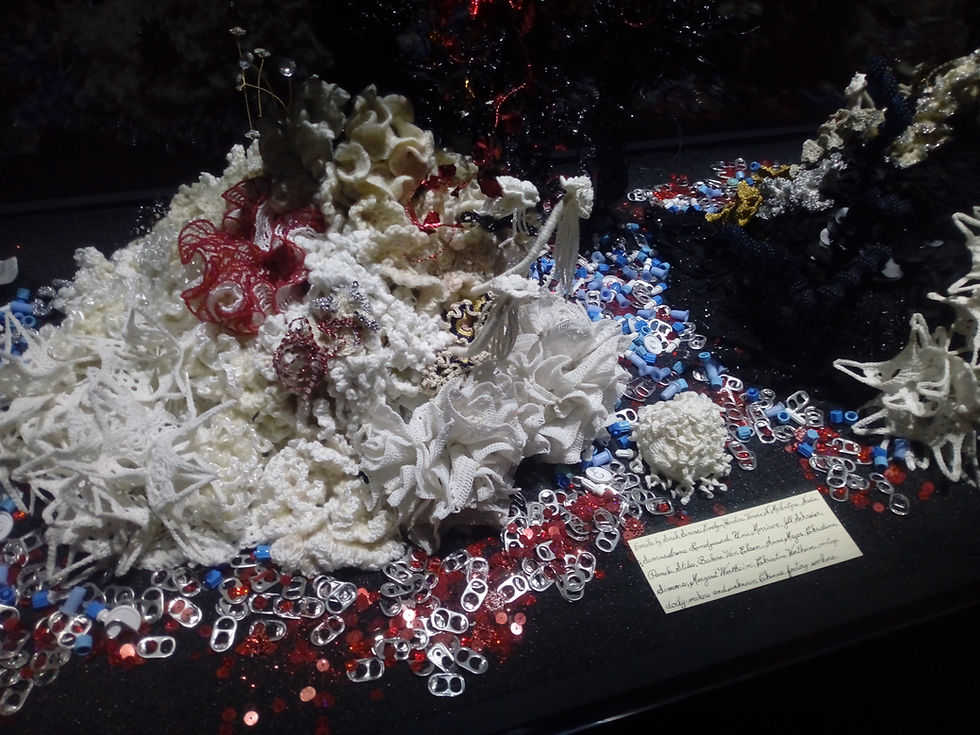THE 58TH VENICE ART BIENNALE | THE ENVIRONMENTAL EMERGENCY
- Eleni Kyriacou
- Aug 5, 2019
- 3 min read
Updated: Sep 3, 2022
The environmental emergency was in my opinion the most prominent theme explored throughout this Biennale, which seems logical. It is clearly on the minds of most, perhaps all artists, at this moment in time. Some artists touched on the subject, others delved into it and others were loudly vocal – quite literally. All expressed via a range of means and from different viewpoints. All saying something different and yet united in the essential cause.

Textile and mixed media sculpture by Christine and Margaret Wertheim
So, it was no surprise when I heard the winner of the Biennale was the Lithuania pavilion which was solely focused on the environmental emergency. It was an installation/performance piece where performers sunbathed on an artificially installed sandy beach whist operatically singing about issues relating to the climate crisis.
There were countless sculptures, installation pieces, collages and other mixed media works that incorporated reclaimed materials in their making. Of these I have made a small selection of ones which stood out to me the most in the moment.
Below is a sculpture that was in the main Arsenale exhibition made from garden hoses in what appears to be the symbol of infinity. I loved the simplicity of this piece. I thought it was powerful and cleverly designed.
Another artist that I adored was Ghanian El Anatsui. His pieces Opening of Time and Earth Shedding its Skin were two of the most powerful in the Biennale. The works are giant screens made of bottle caps and wire. The result is metallic and mosaiced membrane like works that evoke an incredible amount of sensitivity, texture, beauty, a sense of ephemerality and fragility and a reminder of how inventive an artist can be with the most humble of materials – rubbish.
Turning rubbish into art comes across to me, over my lifetime as slowly becoming the necessary way of life for an artist with any true sensitivity as to what this planet is now facing. What was once perhaps a test to measure one’s creativity – when Picasso put pieces of newspaper into art work, I don’t think he was thinking about the environment, but how far can he go with a piece of newspaper, what if he can reinvent it into art? Breathe new life into it? When Duchamp turned a toilet into art, I doubt he was concerned about issues of the planet either but was excited by pushing the boundaries of what we define as art, and elevating the disregarded toilet into art, because he said so. Yet now, the meaning of turning rubbish into art has evolved light years beyond Picasso and Duchamp. The environmental emergency is intrinsic to it and cannot be ignored as a separate issue when one sees an artist engaged in ‘upcycling’. Even if the artist claims the environment is not a primary concern to the piece, it simply is, it is projected in today’s context, whether or not is it intended to be an overriding factor. In fact if an artist chooses not engage in use of reclaimed waste, or in messaging via their work in some way with regards to the environmental emergency, then to me, at this point, it becomes more noticeable (than engaging) and I may ask myself ‘why are they choosing not to address this?’. The one constant that has perhaps remained unchanged amongst many artists, both before scientists made us aware of how much we were harming our natural habitat, and since, is their lack of wealth, so use of reclaimed materials has often been an economic choice or even necessity, not always an intellectual choice.
And then of course, like the prize-winning Lithuania pavilion, other artists were addressing the various planetary crises via other mediums and techniques. Another example was the Canada pavilion that discussed an important native/political theme via a documentary like methodology. So, again, where Lithuana crossed over from the more traditional creative techniques to performance/opera/installation, Canada for me, crossed over too, via the means of filming and text documentation. This really excited me because it creates new possibilities for art.






































































Comentarios